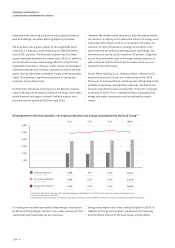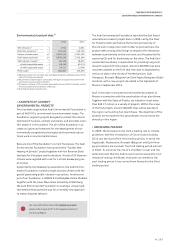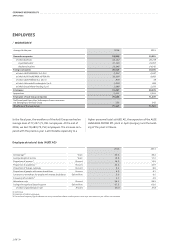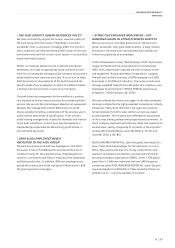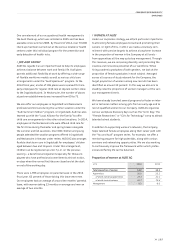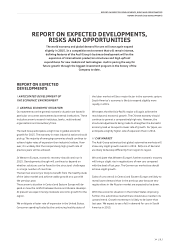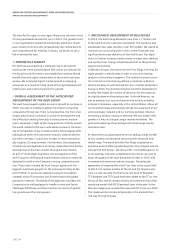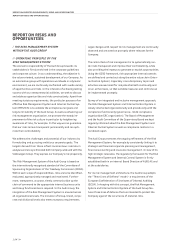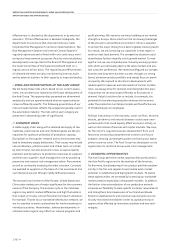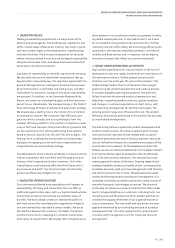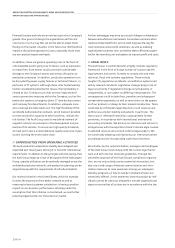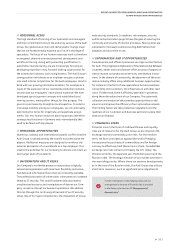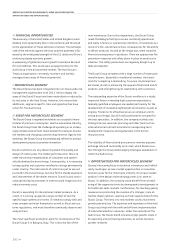Audi 2014 Annual Report Download - page 194
Download and view the complete annual report
Please find page 194 of the 2014 Audi annual report below. You can navigate through the pages in the report by either clicking on the pages listed below, or by using the keyword search tool below to find specific information within the annual report.
REPORT ON EXPECTED DEVELOPMENTS, RISKS AND OPPORTUNITIES
REPORT ON RISKS AND OPPORTUNITIES
194
>>
REPORT ON RISKS AND
OPPORTUNITIES
/
THE RISK MANAGEMENT SYSTEM
WITHIN THE AUDI GROUP
//
OPERATING PRINCIPLE OF THE
RISK MANAGEMENT SYSTEM
The economic responsibility of the Audi Group towards its
stakeholders is firmly enshrined in the corporate guidelines
and corporate culture. In our understanding, the objective is
the value-oriented, sustained development of our Company. As
an automotive group with operations worldwide in a dynamic
environment, we are continually confronted with a wide variety
of opportunities and risks. In the interests of achieving lasting
success with our entrepreneurial activities, we seek to discuss
and address opportunities and risks constructively. Apart from
meeting statutory requirements, the particular purpose of an
effective Risk Management System and Internal Control Sys-
tem (RMS/ICS) is to validate the entrepreneurial goals and
long-term viability of the Audi Group. As well as enhancing our
risk management organization, we promote the steady im-
provement of the risk culture in particular by heightening
awareness of risks, for example. In this way we can guarantee
that our risks remain transparent permanently and can opti-
mize their controllability.
We address the challenges and potential of our industry by
formulating and pursuing ambitious corporate goals. The
targets derived from these reflect conscientious risk/return
analyses and are synchronized both Company-wide and with the
Volkswagen Group. They express our Company’s risk propensity.
The Risk Management System of the Audi Group is based on
the internationally recognized standard of the Committee of
Sponsoring Organizations of the Treadway Commission (COSO).
Within each scope of responsibilities, risks are to be identified,
evaluated, appropriately managed and monitored. Further-
more, transparent, accurate, timely communication up the
chain of command to the appropriate internal business units
and Group functionalities is required. In the Audi Group, the
integration of the Risk Management System is ensured across
all organizational levels. The inclusion of Group, brand, corpo-
rate and divisional levels also meets statutory requirements.
Legal changes with respect to risk management are continually
observed and are acted on promptly where relevant for the
Company.
The central task of risk management is to systematically ren-
der risks transparent and improve their controllability, while
also providing the impetus to generate or exploit opportunities.
Using the COSO framework, risk-appropriate internal controls
are defined and carried out along the entire value chain (Inter-
nal Control System). Especially cross-disciplinary topics and
activities are examined for risk potential both continually and
on an ad hoc basis, so that suitable measures and controls can
be implemented promptly.
By way of an integrated and inclusive management approach,
the Risk Management System and Internal Control System is
closely interlocked organizationally and procedurally with the
compliance functionality (governance, risk & compliance
organization/GRC organization). The Board of Management
and the Audit Committee of the Supervisory Board are kept
regularly informed about the Risk Management System and
Internal Control System as well as compliance matters in a
combined report.
The Audi Group promotes the ongoing refinement of the Risk
Management System, for example by consistently linking it to
strategic and financial corporate planning and management,
financial accounting and insurance management. In view of its
high strategic relevance, the regulatory framework for the Risk
Management System and Internal Control System is firmly
established both in an internal Board Directive of AUDI AG and
at the subsidiaries.
For its risk management architecture, the Audi Group adopts
the “Three Lines of Defense” model – a requirement of the
European Confederation of Institutes of Internal Auditing
(ECIIA). In keeping with this concept, the Risk Management
System and Internal Control System of the Audi Group fea-
tures three lines of defense that are intended to protect the
Company against the occurrence of material risks.


